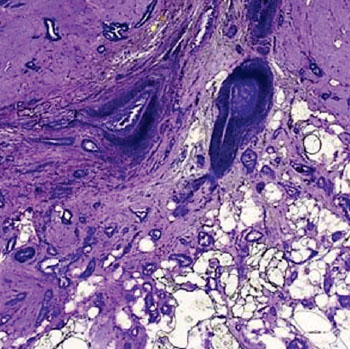Frozen Section Analysis for Breast Cancer Saves Time
By LabMedica International staff writers
Posted on 15 Mar 2016
When diagnosed with breast cancer, women may have thousands of questions running through their minds, but one they may not have immediately is: Will my choice of provider save me time and money? Posted on 15 Mar 2016
In the current health care environment, cost effectiveness is critically important in policy setting and care of patients. A health economic analysis has been performed to assess the implications to providers and payers of expanding the use of frozen section margin analysis to minimize reoperations for patients undergoing breast cancer lumpectomy.

Image: A stained frozen section slide used for the analysis while a patient is still on the operating table (Photo courtesy of the Mayo clinic).
Doctors at the Mayo Clinic (Rochester, MN, USA) and the consultants have built a health care economic impact model to assess annual costs associated with breast lumpectomy procedures with and without frozen section margin analysis to avoid reoperation. This different way uses intraoperative frozen section analysis to determine whether the tumor was removed completely during the first surgery. Doing this in a widespread manner could save untold hours of lost work, anxiety and more for women and tens of millions of dollars.
The investigators found that if frozen section margin analysis is used in 20% of breast lumpectomies and under a baseline assumption that 35% of initial lumpectomies without frozen section analysis result in reoperations, the potential annual cost savings are USD 18.2 million to payers and USD 0.4 million to providers. Under the same baseline assumption, if 100% of all health care facilities adopted the use of frozen section margin analysis for breast lumpectomy procedures, the potential annual cost savings are USD 90.9 million to payers and USD 1.8 million to providers. On the basis of 10,000 simulations, use of intraoperative frozen section margin analysis yields cost saving for payers and is cost neutral to slightly cost saving for providers.
The authors concluded that their economic analysis indicates that widespread use of frozen section margin evaluation intraoperatively to guide surgical resection in breast lumpectomy cases and minimize reoperations would be beneficial to cost savings not only for the patient but also for payers and, in most cases, for providers. Elizabeth Habermann, PhD, scientific director and co-author of the study said, “Our surgery and pathology teams intrinsically knew that this relatively unique practice was not only best for patients but also saves costs. The study shows how the whole care episode must be considered when determining total cost and value of a health service.” The study was published on February 23, 2016, in the Journal of Oncology Practice.
Related Links:
Mayo Clinic













